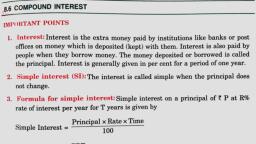Question 1 :
When two vessels containing different quantity of water in it are heated to the same temperature difference, then which vessel will heat up fast?<br/>
Question 3 :
State whether true or false :<br>During the change of state, the temperature does not change.
Question 5 :
At equilibrium temperature, the rate of flow of heat energy from one body to the other and back is the same. Is the statement True or False
Question 6 :
Railway tracks have gaps between them to deal with expansion in :
Question 9 :
The quantity of heat energy required to change the temperature of one gram of water by one degree Celsius is known as<br>
Question 10 :
A thermodynamical system is changed from state $(P_1, V_1)$ to $(P_2, V_2)$ by two different processes, the quantity which will remain same will be
Question 11 :
<span class="wysiwyg-font-size-small"><span class="wysiwyg-font-size-small"></span></span><p class="wysiwyg-text-align-left">The Product of pressure and volume has the same units as </p>
Question 13 :
A gas expands 0.25 $\mathrm { m } ^ { 3 }$ at constant pressure 10$ ^ { 3 } \mathrm { N } / \mathrm { m } ^ { 2 } ,$ the work done is
Question 14 :
Which physical quantity determines the direction of flow of heat energy?<br/>
Question 15 :
One mole of ${O}_{2}$ gas having a volume equal to 22.4 liters at $0^oC$ and 1 atmospheric pressure is compressed isothermally so that its volume reduces to 11.2 liters. The work done in this process is then<br>
Question 16 :
Thermal expansion take place due to the ________ energy of the movement of the particles in a substance, forcing the particles further apart.
Question 17 :
In a certain process $500\ cal$ of heat is given to a system and the system does $100\ J$ of work. The increase in internal energy of the system is
Question 18 :
The highest temperatures recorded in 4 different countries are listed below<table class="wysiwyg-table"><tbody><tr><td>Highest temperature</td><td>Country</td></tr><tr><td>127.6$^o$F</td><td>India</td></tr><tr><td>114.8$^o$F</td><td>Nepal</td></tr><tr><td>136.4$^o$F</td><td>Srilanka</td></tr><tr><td>134.0$^o$F</td><td>Pakistan</td></tr></tbody></table>What is the highest temperature listed above?
Question 20 :
When heat energy is given out by a hot substance then the kinetic energy of its molecules _________. Fill in the blank. <br/>
Question 21 :
Select from below, how are temperature and kinetic energy of molecules related to each other?<br/>
Question 23 :
Heating of a wheel on applying brakes is due to the relation
Question 26 :
Which of the following is a restatement of first law of thermodynamics:
Question 27 :
A thermos bottle containing coffee is vigorously shaken. If the coffee is considered as a system, then the temperature of the coffee will ____________.
Question 34 :
<span class="wysiwyg-font-size-small"><span class="wysiwyg-font-size-small"></span></span><p class="wysiwyg-text-align-left">Which of the following statement is true about 1st law of Thermodynamics?</p>
Question 35 :
Assertion (A) : According to the principle of conservation of energy all heat can be converted<br/>into mechanical work<br/>Reason (R) : Due to various losses, it is impossible to convert all heat into mechanical work.<br/>
Question 37 :
Air is expanded from $50$ liter to $150$ liter at $2$ atmospheric pressure ( $1$ atm = pressure =$10^{5} Pa$). The external work done is:
Question 39 :
<b></b>A body was supplied with $4\times 10^6$ mega joules. Express this heat is joules.
Question 40 :
Identify which of the following statement does NOT apply to the First Law of Thermodynamics?<br/>
Question 41 :
In a given process, $$15 J$ of heat is added to an ideal gas and the gas does $7 J$ of work. Which of the following is true about the internal energy of the gas during this process?<br/>
Question 42 :
State whether true or false :<br>Heat is a form of energy which produces feeling of hotness.
Question 43 :
In a thermodynamic process pressure of a fixed mass of a gas is changed in such a manner that the gas releases 20 J of heat and 8 J of work is done on the gas if the initial internal energy of the gas was 30 J. The final internal energy wilI be:
Question 44 :
State whether given statement is True or False<br/>Heat brings about a change in the state of matter.
Question 46 :
When water is heated from 0 $^{\circ} C$ to 4$ ^{\circ} C$, it :
Question 47 :
Which of the following is true when a gas moves freely from one part to another part of rigid system?
Question 48 :
An unknown liquid at a high temperature is safely mixed with normal water until an equilibrium temperature is reached. Some heat is gained by the cold water. Identify by which of the following law this can be explained ?
Question 50 :
If $1 cal = 4.2 J$, then $0.2 cal g^{-1} {\;}^oC^{-1}=......... J kg^{-1} K^{-1}$
Question 51 :
A thermo-dynamical system is changed from state $(P_{1}, V_{1})$ to $(P_{2},V_{2})$ by two different process. The quantity which will remain same will be
Question 52 :
A steel drill is making $180$ Revolutions per minute, under a constant torque of $5 N-m$. If it drills a hole in $7 s$. in a steel block of mass $600 gm$, rise in temperature of the block is $(s= 0.1 cal/gm/ $ <br> ${^ \circ} C$)<br/>
Question 53 :
A system perform work $\bigtriangleup W$ when an amount of heat $\bigtriangleup Q$ added to the system the corresponding change in the internal energy is $\bigtriangleup U$. A unique function of the intial and final states (irrespective of the mode of change ) is
Question 55 :
When we switch on the fan in a closed room, the temperature of the air molecules :<br/>
Question 56 :
Air in a cylinder is suddenly compressed by a piston, which is then maintained at the same position. With the passage of time :<br/>
Question 57 :
The amount of work, which can be obtained by supplying 200 cal of heat, is
Question 58 :
Internal energy of $ n_{1} $ mol of hydrogen of temperature $ T $ is equal to the internal energy of $ n_{2} $ mol of helium at temperature $ 2 T . $ The ratio $\dfrac{ n_{1} }{ n_{2}} $ is
Question 59 :
A system is taken from state A to state B along 2 different paths 1 and 2 . The heat absorbed and work done by the system along these 2 paths are ${Q}_{1}$,${Q}_{2}$ and ${W}_{1}$,${W}_{2}$
Question 60 :
In a thermodynamic process, pressure of a fixed mass of a gas is changed in such a manner that the gas molecules given out $30$ J of heat and $10$ J of work is done on the gas. If the initial internal energy of the gas was $40$ J. Then the final internal energy will be
Question 61 :
In a thermodynamic process two moles of a monatomic ideal gas obeys P $\propto V^{-2}$. If temperature of the gas increases from 300 K to 400 K, then find work done by the gas (where $R=$universal gas constant)
Question 62 :
Find the change in internal energy in joule when 10$\mathrm { g }$ of air is heated from $30 ^ { \circ } \mathrm { C }$ to $40 ^ { \circ } \mathrm { C }$
Question 63 :
How much heat energy in joules must be supplied to $14\ gms$ of nitrogen at room temperature to rise its temperature by $ 40^o C $ at constant pressure?<br>(Mol.wt.of $ N_2 = 28 gm , R = constant $)<br>
Question 64 :
A gas expands under constant pressure P from volume $V_{2}to V_{1}$. The work done by the gas is
Question 65 :
One mole of a gas expands with temperature T such that its volume, $V=kT^2$, where k is a constant. If the temperature of the gas changes by $60^oC$, then the work done by the gas is:
Question 66 :
A solid cube and a solid sphere of identical material and equal masses are heated to the same temperature and left to cool in the same surroundings. Then
Question 67 :
Which of the following is an example of the first law of thermodynamics ?
Question 68 :
The work done in which of the following process is zero
Question 69 :
A thermodynamic process, 200 J of heat is given to a gas and 100 J of work is also done on it. The change in internal energy of the gas is
Question 70 :
One mole of an idea gas expands at a constant temperature of 300 K from an initial volume of 10 litres to a volume of 20 litres. The work done in expanding the gas is<br>(R=8.31 J/mole-K)
Question 71 :
Assertion: First law of thermodynamics can be applied for ideal gases only.
Reason: First law is simply, law of conservation of energy.
Question 72 :
Work done in converting 1 g of ice at $- 10^o$C into steam at $100^o$C is
Question 73 :
A cylinder with fixed capacity of $67.2$ lit contains helium gas at STP. The amount of heat needed to raise the temperature of the gas by $20^0C$ is :
Question 74 :
During a cyclic thermodynamic process, a gas absorbs 45 J of heat.<br>Which table correctly describes the change in internal energy in the gas and work done by the gas during this cycle?
Question 75 :
A boy of mass 50 kg runs up a staircase of 45 steps in 9 s. If the height of each step of the staircase is 15 cm, find the power of the boy.
Question 76 :
An ideal diatomic gas is expanded so that the amount of heat transferred to the gas is equal to the decrease in its internal energy.<br>If in the above process, the initial temperature of the gas to be $T_0$ and the final volume be 32 times the initial volume, the work done by the gas during the process will be in joules:
Question 77 :
Pressure P, volume V and temperature T for a certain gas are related by $p=\frac { AT-B{ T }^{ 2 }}{ V }$, where A and B are constants.The work done by the gas as its temperature change from ${ T }_{ 1 }$ to ${ T }_{ 2 }$ while pressure remaining constant is:
Question 78 :
A gas is compressed at a constant pressure of 50 N / $m^{2}$ from a volume of 10$m^{3}$ to a volume of 4$m^{3}$. Energy of 100 J then added to the gas by heating. Its internal energy is
Question 79 :
Assertion: Between two thermodynamic states, the value of $(Q - W)$ is constant for any process.
Reason: $Q$ and $W$ are path functions.
Question 80 :
Assertion: The work done on an ideal gas in changing its volume from $V_1 \space to \space V_2$ under a polytropic process is given by the integral $\int_{v_1}^{v_2} P. dV$ taken along the process.
Reason: No work is done under an isochoric process of the gas.
Question 81 :
An ideal gas expands from volume $ V_1 $ to $ V_2$. This may be achieved by either of three processes: isobaric, isothermal and adiabatic. Let $ \Delta U $ be the change in internal energy of the gas , Q be the quantity of heat added to the system and W be the work done by the system on the gas. Identify which of the following statements is false for $ \Delta U$?<span id="_wysihtml5-undo" class="_wysihtml5-temp"></span>
Question 82 :
Assertion: The internal energy of an isothermal process does not change.
Reason: The internal energy of a system depend only on pressure of the system
Question 83 :
For a diatomic gas, change in internal energy for unit change in temperature at constant pressure and volumes is $U^{}_{1}$ and $U^{}_{2}$ respectively then $U^{}_{1}:U^{}_{2}$ is<br>
Question 84 :
If $110$J of heat are added to a gaseous system, whose internal energy is $40$J, then the amount of external work done is?
Question 85 :
How much heat energy will be required to increase the temperature of the vessel in part (a) from $25^{\circ}C$ to $35^{\circ}C$ ?
Question 86 :
5 mole of helium are mixed with 2 mole of hydrogen to form a mixture. Take molar mass of helium $M_1=4 g$ and that of Hydrogen $M_2=2 g$ <br>If the internal energy of He sample of 100 J and that of the hydrogen sample is 200 J, then the internal energy of the mixture is:
Question 87 :
Assertion: Fahrenheit is the smallest unit measuring temperature.
Reason: Fahrenheit was the first temperature scale used for measuring temperature.
Question 88 :
Assertion: First law of thermodynamics is a restatement of the<br>principle of conservation
Reason: Energy is fundamental quantity.
Question 90 :
$1\ litre$ of an ideal gas $(\gamma = 1.5)$ at $300\ K$ is suddenly compressed to half its original volume.<br/>If the original pressure is $100\ kPa$, find the work done by the gas in the process .<div>Take: $\sqrt 2=1.41$</div>
Question 91 :
A cylinder fitted with a piston contain 0.2 moles of air at temperature $27^{\circ}$. The piston is pushed so slowly that the air within the cylinder remains in thermal equilibrium with the surroundings. Find the approximate work done by the final volume is twice the initial volume
Question 93 :
The first law of thermodynamics is concerned with the conservation of
Question 94 :
<div>Gas in a container absorbs 300 J of heat. After this, 100 J of work is done on it which is followed by 50 J of work done by the gas. The increase in the internal energy of the gas is:</div>
Question 95 :
Two moles of a gas A at $27$ $^o$C mixed with a $3$ moles of gas at $37$ $^oC$. If both are monatomic ideal gases, what will be the temperature of the mixture?
Question 96 :
Consider the following two statements and choose the correct answer :<br>A) If heat is added to a system its temperature must always increase<br>B) If positive work is done by a system in thermodynamic process its volume must increase.<br>
Question 97 :
1 mole of an ideal gas STP is subjected to a reversible adiabatic expansion to double its volume. The change in internal energy $(\gamma = 1.4)$
Question 99 :
In a cyclic process, the amount of heat given to a system is equal to
Question 100 :
A quantity of a substance in a closed system is made to undergo a reversible process from an initial volume of $3 m^{ 3 }$ and initial pressure $10^{ 5 } N/ m^{ 2 }$ to a final volume of $5 m^{ 3 }$. If the pressure is proportional to the square of the volume (i.e, P =$ AV^{ 2 }$), the work done by the substance will be:
Question 101 :
A thermally insulated rigid container contains an ideal gas. It is heated through a resistance coil of 100$\Omega $ by passing a current of 1 A for five minutes, then change in internal energy of the gas is<br/>
Question 102 :
An insulated container containing monoatomic gas of molar mass m is moving with a velocity $v_0$. If the container is suddenly stopped. The change in temperature is?
Question 104 :
STATEMENT-1: There is a natural asymmetry between converting work to heat and converting heat to work.<br/><br/>STATEMENT-2: No process is possible in which the sole result is the absorption of heat from a reservoir and its complete conversion into work.
Question 105 :
Two cylinders $A$ and $B$ fitted with pistons contain equal amounts of an ideal diatomic gas at $300\ K$. The piston of $A$ is free to move, while that of $B$ is held fixed. The same amount of heat is given to the gas in each cylinder. If the rise in temperature of the gas in $A$ is $30\ K$, then the rise in temperature of the gas in $B$ is<br>
Question 106 :
Consider a rectangular block of wood moving with a velocity $v_0$ in a gas at temperature T and mass density $\rho$. Assume the velocity is along x-axis and the area of cross-section of the block perpendicular to $v_0$ is A. The drag force on the block is (where m is the mass of the gas molecule).
Question 107 :
Two identical containers $ A $ and $ B $ have frictionless pistons. They contain the same volume of an ideal gas at the same temperature. The mass of the gas in $ A $ is $ m_{A} $ and that in $ B $ is $ m_{B} $. The gas in each cylinder is now allowed to expand isothermally to double the initial volume. The change in the pressure in $ A $ and $ B $, respectively, is $ \Delta p $ and $ 1.5 \Delta p $ Then
Question 109 :
An iron block of mass $2\;kg$, falls from a height of $10m$. After colliding with the ground it loses $25\%$ energy to surroundings and rest is gained as heat. Then find the temperature rise of the block. (Take sp. heat of iron $470\;J/kg^{\circ}C$)<br/>
Question 110 :
In a thermodynamic process pressure of a fixed mass of a gas is changed in such a manner that the gas releases $20J$ of heat and $8J$ of work is done on the gas. If initial internal energy of the gas was $30J$, what will be the fixed internal energy?





















































